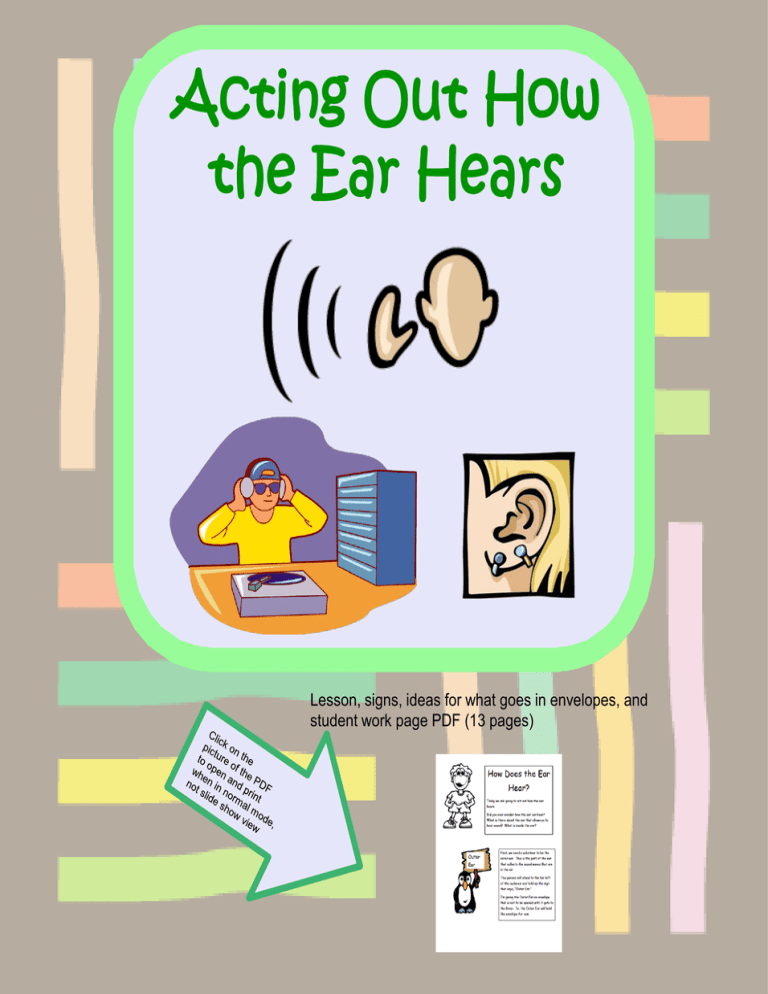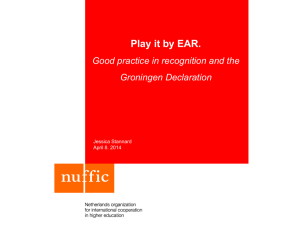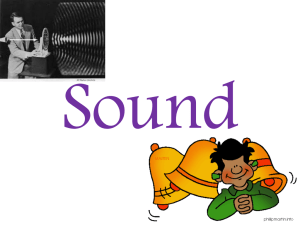Acting Out How the Ear Hears PPt Lesson Work
advertisement

Acting Out How the Ear Hears Lesson, signs, ideas for what goes in envelopes, and student work page PDF (13 pages) How Does the Ear Hear? Today we are going to act out how the ear hears. Did you ever wonder how the ear can hear? What is there about the ear that allows us to hear sound? What is inside the ear? Look at this picture. It may not make too much sense now, but by the end of this lesson it will be easier to understand. Even me? I am going to learn that? Yes! Helpful links with excellent information and a diagram of the inner ear for all students: http://clerccenter.gallaudet.edu/Clerc_Center/Information_and _Resources/Info_to_Go/Hearing_Loss_Information/Hearing_L oss_Younger_Children.html http://clerccenter.gallaudet.edu/Clerc_Center/Information_and_Resources/Info_to_Go/Hea ring_Loss_Information/Understanding_the_Ear.html A volunteer will be the outer ear. This is the part of the ear that collects the sound waves that are in the air. This person will stand to the far left of the audience and hold up the sign that says, “Outer Ear.” The Outer Ear will get an envelope that is not to be opened by anyone but the Brain. So, the Outer Ear will just hold the envelope for now. Now that we have the outer ear, we will need a volunteer to be the ear canal. Ear Canal The ear canal is like a little tunnel that goes from the outer ear to the ear drum. Never put anything bigger than your elbow into the ear canal. Who will volunteer to hold up the ear canal sign, and stand next to the Outer Ear? At the end of the ear canal is the ear drum. When you have an earache, this is the part of the ear that might bulge or even tear a little. Ear Drum There would be pressure on the ear drum. The ear drum divides the outer and middle ear. The ear drum stands next to the ear canal. Next in line after the outer ear, ear canal, and ear drum. We will need volunteers to be the hammer, anvil, and stirrup. These are three tiny bones in the middle ear that also move when sound waves travel through your ear. But do you know what, the ear still hasn’t actually heard anything. The parts have just moved a little! Here are the parts of the ear in order: (just keep pressing the space bar, the words have animation) These are the parts of the ear SO FAR, there are more on following slides. Now let’s see what is next! We need a volunteer to be the Cochlea. The hair cells in the cochlea move very fast when sound waves hit them. They vibrate. The hair cells change the clapping sound to a kind of electricity. The Cochlea is in the inner ear. Next we need a volunteer to be the Auditory Nerve. The Auditory Nerve carries the sound waves to the Brain to interpret the sounds into “hearing.” The electricity moves up the auditory nerve to your brain. The brain uses the sound waves to hear what the sounds really are. The brain hears! The ear and ear parts collect sound waves and move them along to the auditory nerve and finally the Brain! So, now we will pass the envelope along in order from the outer ear to the brain. Wiggle (to show the sound waves) as you pass the envelope along. The Brain will open the envelope and tell us what sounds the ear collected. Brain, open the envelope and read the message aloud! The ear collects the sounds, the brain "hears" the sounds. Volunteers will give their signs to other students who will try to find their correct places in the order of the ear parts. A new envelope, please! Was the line up correct? Great Work! Even me! I understand it now! Yes! Here are the parts of the ear in order: (just keep pressing the space bar, the words have animation) Attachments ActingOutHowtheEarHearsPDF.pdf






